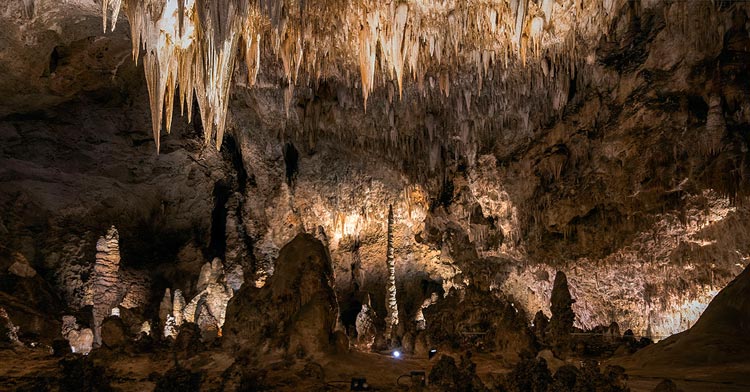
A magical world for your imagination exists 750 feet below the surface of the earth in the Southwestern United States. At Carlsbad Caverns, names like “The Lions Tail,” “Breast of Venus,” ”Dolls Theater,” “Hall of Giants,” “The Caveman,” “The Chandelier” and “The Rock of Ages” are all formations in the subterranean world of Carlsbad Caverns National Park in New Mexico.
The National Park Service has recently introduced a virtual tour of Carlsbad Caverns in New Mexico, which offers an up-close view of these amazing natural formations.
Read on to see why you’ll want to visit — either virtually or in person.
Carlsbad Caverns
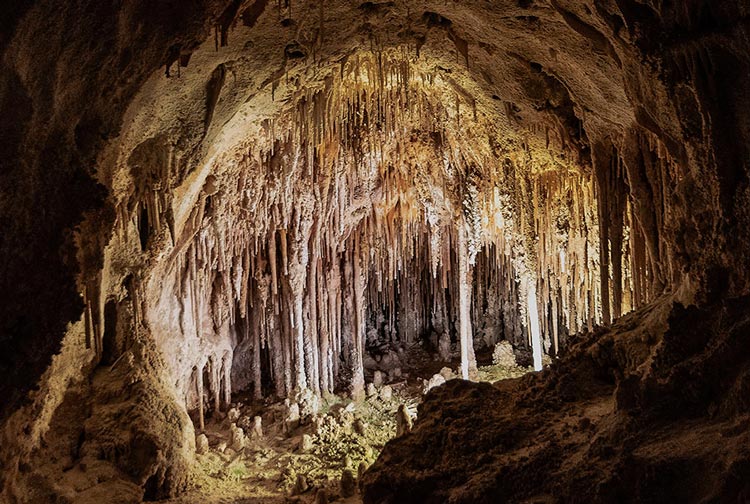
Comedian Will Rogers called Carlsbad Caverns the “Grand Canyon with a roof on it” when he visited in the 1930s.
My ears popped as I descended the equivalent of a 75-story building in one minute in an elevator from the visitor center to the starting point of my adventure into the dark world of stalactites and stalagmites. There are two ways to reach the main cave in the park.
Both lead to the beginning of the self-guided, more than a mile-long trail through the “Big Room.” One is to hike down the switch-backed path from the Natural Entrance. The other is to use the elevator. Before the elevator was installed you could be lowered in a guano bucket
‘Big Room’ is the Fifth-largest Cave in the World
Carlsbad Caverns‘ 4,000-foot “Big Room” the fifth-largest cave in the world overwhelms you as you enter. You could hide an army in its huge expanse of more than six football fields.
The Carlsbad Cavern is a constant and cool 56 degrees. It is dark down here. While many lights illuminate the pathway and its formations, the huge expanse seems to swallow light, leaving you to move slowly.
You can hear the dripping sounds of the cave growing around you. Water is the great decorator of caverns. It is also very quiet. Everyone whispers to each other as they wander the paved trail as if in church. It could be called nature’s underground cathedral.
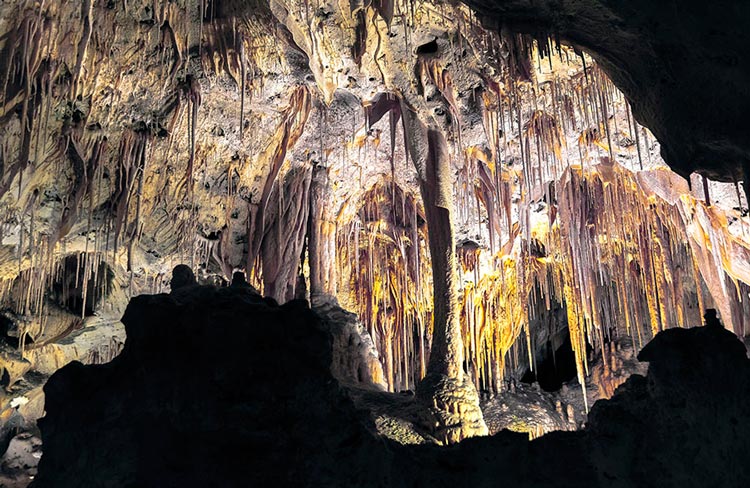
I entered the Jim White Tunnel, named after the man who discovered the caverns in 1898, and the first of several fanciful formations came into view.
The Chinese Theater has stalagmites in a large overhanging room that seems ready to act out a play. The Dolls Theater is a small recessed room with numerous soda straws, and the Painted Grotto has stalactites hanging from the ceiling like swords.
The paved path with steel railings winds into the huge cavern past the Rock of Ages column that was once a stalagmite that grew inch by inch over many decades to connect with the ceiling to become a column.
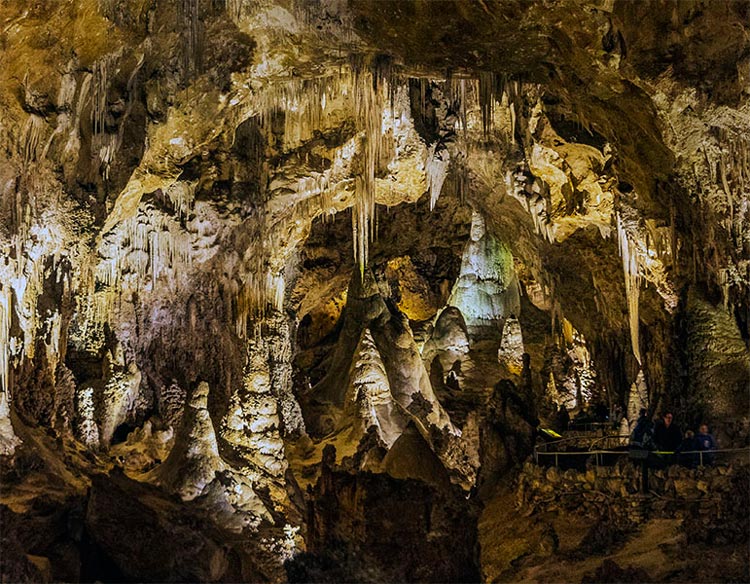
The Chandelier is the Largest of the Stalactites
The expanse of the “Big Room” is hard to fathom. It stretches into the darkness with the ceiling rising and lowering as you walk along. Stalactites cover the roof of the cavern and the largest of these is called The Chandelier.
It hangs over a large open room of formations such as the “Caveman,” “Totem Pole” and a variety of smaller stalagmites that create the impression of a grand, dimly lit, stony ballroom filled with rocky guests.

A concrete amphitheater, where lectures are held in the cave, is located at the “Top of the Cross.” This vantage point gave me a great view back into the dark and grand expanse of the cave.
The “Bottomless Pit” is a dark hole that seems to absorb all the available light. Rocks dropped into the chasm make no sound as they descend into the depths. Early explorers thought it was bottomless. It was determined to be only 140 feet deep with a soft dirt floor that absorbed the noise of the falling stones, leading to the misconception of its depth.
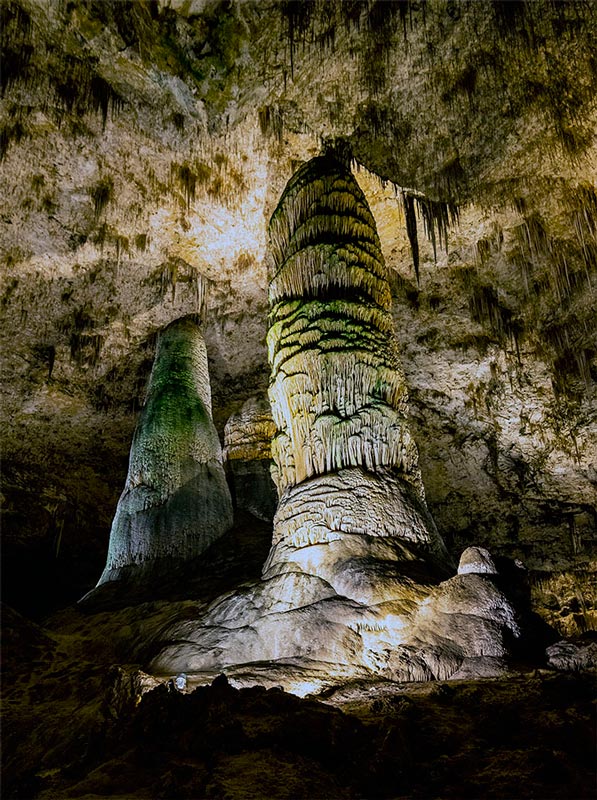
The entrance to the “Left Hand Tunnel” cave is nearby, and you can take a ranger-guided tour to explore it. Soon I entered the “Hall of Giants,” a wondrous collection of large stalagmites of various heights. You walk slowly so as not to disturb these rocky monsters as you gaze up at them.
Scattered along the floor of the cave are small round and oval objects called “cave pearls” that are sprinkled among smaller stalagmites in the area called “Fairyland.” The “Temple of the Sun” features a large stalagmite that is surrounded by sharp pointy stalactites that glow in the light from a spotlight.
I walked past the “Breast of Venus” and the “Lions Tail” formations as I made my way back toward the entrance. I could understand why this cavern was used to film the movie “Journey to the Center of the Earth” in the 1950s. It felt like I had descended into another world.
The path to the Natural Entrance branches off the trail near the entrance to the “Big Room.” This is the other self-guided tour you can take in the caverns. I would walk down this trail and take the elevator back to the surface to save time and energy.
Resident Bats Stream Out of the Caverns at Night
The Natural Entrance passes by the home of the caverns’ resident bat population. Thousands of Mexican free-tailed bats stream out of the entrance in the evening, May through October, resembling a cloud of dark smoke as they leave.
The bats were the source of the only “mining” in the caverns – for their “guano” – which was hauled out in large buckets to be made into fertilizer.
My exploration of the “Big Room” ended at the underground lunchroom. At 750 feet below the surface, it is probably the deepest underground of any cafeteria. Only a limited selection of food options is offered, and you cannot take any food or drink into the caverns.
This is also the starting point for several of the ranger-guided tours, for which you need to purchase tickets in advance. You can mail a postcard from the deepest underground mailbox of the U.S. Postal Service before you board the elevator for the return to the world above.
Words don’t adequately describe the wonders of this world carved out of limestone over eons, so I took a few pictures using long exposures, a tripod, and patience to capture images that will help you envision this fantasy world deep beneath the Guadalupe Mountains of the Chihuahuan desert of New Mexico.
If You Go:
Carlsbad Caverns National Park is open every day except Christmas. Hours are 8 a.m. to 5 p.m. from September to May, and until 7 p.m. from May to September. Entrance fees are $15 per person; no charge for children under 15. Ranger-led tours cost extra and should be reserved online or at the visitor center. Get more info at NPS.Gov.
The nearest international airport is El Paso, Texas, 145 miles from the park. The town of Carlsbad, N.M., 18 miles from the park, has good hotel and restaurant options. Local airlines provide service to Carlsbad, but having a car is a real advantage.
Author Bio: Jim Chamberlain is an award-winning photographer and travel writer from Olympia, Wash. He has traveled extensively to Europe, Asia, the Caribbean, South America, Central America, Australia and the South Pacific. He especially loves the national parks of the U.S. You can see more of his photography at https://fineartamerica.com/profiles/jim-chamberlain
